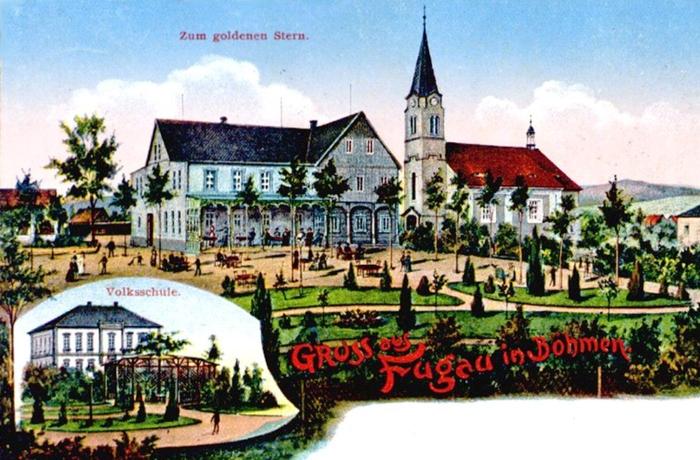
The disappeared town of Fukov / Fugau far in the north - Horydoly.cz - Outdoor Generation
The town of Šluknov published the Czech-German brochure Fukov/Fugau in 2010. It was compiled by Helga Hošková. The publication is free.
Prominent natives of Fugau
August Weirich (1858-1921) bandleader of the St. Stephen's Cathedral Rudolf Kauschka (1883-1960) mountaineer and sledder Jindřich Roudný (1924-2015) light athlete
The small town of Fukov, better known by its German name Fugau, is deserted today.
Bohemia extends to the Spree
Fugau lies on a narrow strip of Czech territory running sharply from the Šluknovský promontory further north to the German town of Oppach. A 4 kilometer long and 400 meter wide piece of landscape is connected to the Czech hinterland. Fugau used to be the northernmost municipality of the Czechoslovak Republic.
The river Spreva / Spree flows into this narrow promontory on the territory of the Czech Republic. Today, the cadastre of Fukova belongs to the town of Šluknov (Schluckenau).
The German railway runs through it, but the station was never built on Czech territory. Only a bridge over the railway was built. He gained dubious fame in 1938, when Adolf Hitler entered the Czechoslovak Sudetenland under him. Deutsche Bahn trains still run here today.
German Protestants defended themselves against Czech Catholics
The first written mention of Fugau dates from 1474 and confirms that the village is in the possession of the Saxon dukes. Already then, there were mainly ethnic Germans living here and this did not change until 1960, when the village was liquidated, the church and school were blown up and the houses demolished. "They were blowing up Fukov. Graves, monuments, coffins were flying," recalled Josef Rutte, who later lived in Česká Kamenice, of the meeting of his natives.

Fukov was Protestant at the time of the Reformation, and after the Thirty Years' War it was not possible to re-Catholicize the village for a long time, as the neighboring Saxon villages of Opach and Taubenheim remained Protestant. Re-Catholicization did not succeed until 1697.
In 1716, the Fukov court was abolished and the Dominican settlement of Nový Fukov was established on its divided lands, which developed rapidly. The division into Old and New Fukov was used until the 20th century. Starý Fukov lay between the later Saxon railway and the Spree, Nový Fukov from the line towards Bohemia to the Kingdom.
The new church of St. Wenceslas in Fukov was consecrated in 1788.
In September 1813, an incredible 60,000 Russian soldiers under the command of General Langeron were encamped in Fukov, chasing Napoleon's Grande Armée.
5 pubs in one town
During the Czechoslovak Republic in 1921, there were 135 houses and 739 inhabitants lived in them. After World War II, most of the Germans were expelled, and in 1950 there were only 87 inhabitants left. They too were evicted within ten years.
The three bells from the church in Fugau were taken to the church of St. Francis of Assisi in Studánka in 1960 and are now located in the church of St. Bartholomew in Rumbur. They came to Fukov in 1594 from Roudnice nad Labem, when the city of Litoměřice ordered them from the local bell ringer as a gift to Fukov.
The defunct village of Fukov / Fugau is commemorated by a wooden cross planted in 2000. Part of the cemetery is repaired. The reservoir on the slope was reconstructed, which was the only one that the communists did not destroy in 1960. The Passion of the Lord by the road to Taubenheim was reconstructed and new fruit avenues were planted along the Fuk roads.
Before the Second World War, the population of Fukov was mostly engaged in cattle breeding and agriculture. In addition to the church, there was a two-classroom municipal school in the village, a joint building of the Czech and German financial guards (Austrian and German until 1918), and 58 businesses operated here.
5 inns operated in Fukov. In Nové Fukov there was the inn Zum Hopfenberg (Near the Hop Hill) and Zur deutschen Grenze (Near the German border), in Staré Fukov Der goldene Stern (Golden Star), Zum Kretscham (Tavern) and Vereinhaus (Union House).
There were only two cars in Fukov in the 1930s. They were owned by factory worker Michalíček and butcher Knobloch. There was no bus connection. A postman came to the village daily.
The Germans wanted to stay in Bohemia. They almost succeeded
Despite their majority German origin, the inhabitants claimed to belong to the Czech lands. The Fukovský promontory was supposed to be annexed to German Saxony three times, but the people rejected it in referendums in 1848 (for Austria-Hungary) and 1919 (for Czechoslovakia). After the Second World War and the removal of the German population, no one asked anyone anymore, and the 277-hectare area was to be exchanged in 1956 for an equally large piece of land near Studánka near Varnsdorf. To this day, it is not clear why the exchange and adjustment of borders did not take place.
Between 1945 and 1947, the Germans were pushed out of Fugau. Many settled just beyond the border river Spree in Oppach and remained only a few tens of meters from their homes. However, they lost real estate and other assets. Several families went to Kempten in the Allgav Alps and their members never looked at Bohemia or the Sudetenland again.
Booking.com
Transportation
It is possible to come to the former Fukovo on foot or by bike. From Šluknov follow cycle path No. 3043 towards Jiříkov and from the rescue point DC033 follow the forest road directly north to Fukov. From Germany along the Spree cycle path to the junction with the Fugauer Strasee and south across the river on a paved dirt road. There is no tourist sign leading to Fukovo.
Show the place Turistika on a larger map







